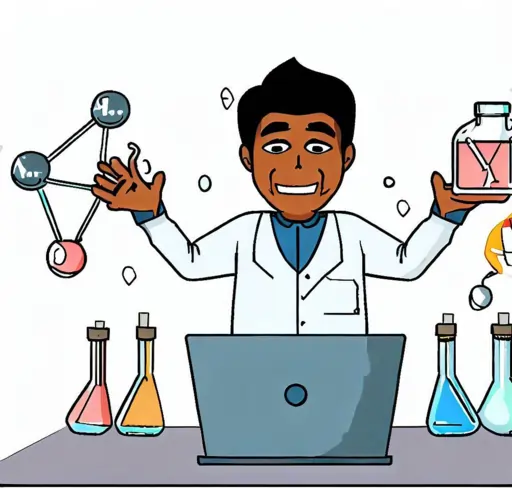Redox reactions, short for reduction-oxidation reactions, are fundamental chemical processes that play a crucial role in our daily lives. From the rusting of iron to the combustion of fuels, redox reactions are all around us. Understanding the key concepts in redox reactions is essential for students studying chemistry, as these reactions are a common topic in assignments and exams. However, tackling redox reactions can be challenging, and students often encounter common pitfalls when completing their Chemistry assignments. In this comprehensive guide, we will delve into the key concepts of redox reactions and explore the most common pitfalls students should avoid when working on assignments related to this topic.
Part 1: Key Concepts in Redox Reactions
In this part, we delve into the core concepts of redox reactions: oxidation and reduction, oxidation states, half-reactions, and various types of redox reactions. These fundamentals form the foundation for understanding and tackling complex chemical reactions.

1.1 Oxidation and Reduction
At the heart of every redox reaction lie two fundamental processes: oxidation and reduction. Understanding these processes is crucial when dealing with redox reactions.
- Oxidation: Oxidation is a fundamental process in redox reactions. It involves the loss of electrons by a substance, resulting in an increase in its positive charge. This process often occurs alongside the addition of oxygen or the removal of hydrogen from a substance. Recognizing oxidation is crucial when analyzing chemical reactions in assignments, as it's a key indicator of the transformations occurring in redox processes, providing valuable insights into the overall reaction dynamics.
- Reduction: Reduction, a crucial concept in redox reactions, involves the gain of electrons by a substance. This process results in a reduction in the substance's oxidation state and an increase in its electron density. Students need to recognize reduction as one of the two fundamental processes in redox reactions, alongside oxidation. It's vital for accurately identifying which substances are reduced during a reaction, a skill essential for success in chemistry assignments and assessments.
1.2 Oxidation States
Oxidation states, also known as oxidation numbers, are used to track the flow of electrons in redox reactions. Every element in a compound is assigned an oxidation state, which indicates whether it has lost or gained electrons.
- Rules for Assigning Oxidation States: Following rules for assigning oxidation states is paramount in chemistry assignments. These rules provide a systematic way to determine the oxidation state of each element within a compound, ensuring precision in redox reactions analysis. For instance, knowing that oxygen typically has an oxidation state of -2 and hydrogen +1 helps assign oxidation states accurately, a crucial step for balancing equations and comprehending the electron transfer within reactions.
- Change in Oxidation States: Change in oxidation states is a fundamental aspect of redox reactions. Recognizing how oxidation states shift during a reaction is vital in chemistry assignments. The element that gets oxidized increases its oxidation state, while the one being reduced decreases it. This knowledge allows students to accurately identify and analyze redox reactions, helping them excel in assignments that involve these critical chemical processes.
1.3 Redox Reactions and Half-Reactions
Redox reactions can be broken down into two half-reactions: one representing the oxidation process and the other representing the reduction process. This separation simplifies the analysis of complex redox reactions.
- Balancing Redox Equations: Balancing redox equations is a crucial skill for students working on chemistry assignments. It involves ensuring that the number of electrons lost in the oxidation half-reaction is equal to the number gained in the reduction half-reaction. This meticulous balancing process ensures that the overall charge and mass remain conserved during the reaction. Students who master this skill can accurately represent complex redox reactions in a balanced and concise manner, a key requirement in assignments and exams involving these reactions.
1.4 Redox Reaction Types
There are several types of redox reactions, including:
- Combination Reactions: Combination reactions, a common type of redox reaction, involve two or more substances coming together to form a single product. Typically, one of the reactants gets oxidized while the other gets reduced. This type of reaction often results in the creation of new compounds with distinct properties, making it important for students to recognize it accurately in assignments and understand the underlying principles of electron transfer and chemical transformation involved in combination reactions.
- Decomposition Reactions: Decomposition reactions are a crucial aspect of redox chemistry assignments. In these reactions, compounds break down into simpler substances. Students must identify which component is oxidized and which ones are reduced. This understanding enables accurate balancing of equations and predictions about the products formed. Mastery of decomposition reactions equips students with essential problem-solving skills, helping them excel in their chemistry assignments and enhancing their overall comprehension of redox chemistry.
- Displacement Reactions: Displacement reactions are a significant category within redox reactions. In these reactions, one element in a compound is replaced by another element, resulting in the formation of a new compound. It's crucial to recognize the element that gets displaced, as it undergoes oxidation, while the displacing element undergoes reduction. This understanding is vital for correctly identifying and balancing displacement reactions, a key skill for success in chemistry assignments and assessments.
- Combustion Reactions: Combustion reactions are crucial in both chemistry and everyday life. Understanding these reactions is vital in assignments as they involve the rapid reaction of a substance with oxygen, typically producing heat and light. Common examples include the combustion of fuels like gasoline in engines or the burning of wood in a fireplace. Mastering combustion reactions is key to comprehending energy release processes and their environmental implications, making it an essential concept for students in their assignments and beyond.
Part 2: Common Pitfalls to Avoid When Completing Assignments
Common pitfalls in chemistry assignments often involve incorrect oxidation state assignments, failure to balance redox equations properly, and misidentifying non-redox reactions. Attention to detail and practice can help students navigate these challenges successfully.
- Failure to Assign Oxidation States Correctly
- Incorrect Balancing of Redox Equations
- Misidentifying Redox Reactions
- Overlooking Reaction Conditions
- Neglecting Half-Reactions
- Relying Too Heavily on Memorization
- Lack of Practice
One of the most frequent pitfalls in chemistry assignments is the inaccurate assignment of oxidation states. This error can have a domino effect, leading to flawed calculations and a misunderstanding of the overall redox reaction. It's crucial to follow the rules meticulously when determining oxidation states for each element in a compound. This typically involves considering electronegativity, the element's position in the periodic table, and the molecule's overall charge. Ensuring the correct assignment of oxidation states is fundamental to accurately analyzing and balancing redox equations, making it a critical skill for students to develop and practice.
Balancing redox equations is another common stumbling block in chemistry assignments. Each half-reaction must be balanced separately to ensure that the number of electrons lost during oxidation matches the number gained during reduction. Neglecting this step can lead to confusion and incorrect results. Students often forget to account for electrons when balancing equations, making it crucial to meticulously adjust coefficients to achieve electron equality. Developing proficiency in balancing redox equations is essential for a comprehensive understanding of these reactions and for successfully completing assignments in the field of chemistry.
Misidentifying redox reactions is a common pitfall that can lead to incorrect assignments in chemistry. Not all chemical reactions are redox reactions, and failure to distinguish between them can result in errors. It's essential to understand the criteria for classifying a reaction as a redox reaction, such as changes in oxidation states. Students may mistakenly assume a non-redox reaction is a redox reaction, leading to incorrect analyses and solutions. Clear comprehension of the distinguishing characteristics of redox reactions is vital to avoid this pitfall and to ensure accurate assignment completion in chemistry studies.
Overlooking reaction conditions is a significant pitfall when tackling chemistry assignments, particularly those involving redox reactions. Temperature, pressure, and other environmental factors can substantially influence the outcome of a chemical reaction. Ignoring or incorrectly considering these conditions can lead to incorrect interpretations and predictions. For instance, changes in temperature might affect reaction rates or shift equilibriums in redox reactions. Therefore, students must account for reaction conditions as they analyze and complete assignments to ensure their work aligns with the principles of chemical kinetics and thermodynamics, enhancing the accuracy and comprehensiveness of their responses.
Neglecting to break down redox reactions into half-reactions is a common pitfall among students, especially when faced with complex assignments. Half-reactions represent the separate oxidation and reduction processes within a redox reaction, simplifying the analysis. By omitting this crucial step, students may find themselves overwhelmed by convoluted equations and struggle to grasp the fundamental changes in oxidation states. Utilizing half-reactions allows for a more systematic approach to balancing equations, ensuring that the electrons lost during oxidation are equal to those gained during reduction. This practice enhances clarity, reduces errors, and facilitates a deeper understanding of the underlying chemistry, making assignments more manageable and accurate.
Relying excessively on memorization is a common pitfall when dealing with redox reactions in chemistry assignments. While memorizing certain rules and equations is essential, understanding the underlying concepts is equally crucial. Redox reactions involve complex processes that go beyond mere rote memorization. Overreliance on memorization can hinder problem-solving skills and limit a student's ability to apply their knowledge to diverse scenarios. By focusing on comprehension and critical thinking, students can approach assignments with confidence, adapt to different situations, and tackle complex problems effectively. Encouraging a deeper understanding of redox reactions rather than mere memorization leads to a more robust foundation in chemistry.
A lack of practice is a pitfall that can hinder a student's ability to excel in chemistry assignments, especially those involving redox reactions. These reactions often require precise calculations and a keen understanding of the underlying principles. Without regular practice, students may struggle to apply theoretical knowledge to real-world scenarios. It's crucial to work through numerous practice problems to solidify one's comprehension and hone problem-solving skills. Frequent practice builds confidence, reduces the chances of errors, and helps students develop an intuitive grasp of redox reactions, making assignments more manageable and ensuring better performance in exams.
Conclusion
Redox reactions are a fundamental topic in chemistry, and understanding their key concepts is essential for success in the subject. By grasping the concepts of oxidation, reduction, oxidation states, and redox reaction types, students can navigate redox reactions more effectively. Additionally, by being aware of common pitfalls and avoiding them, such as misassigning oxidation states or failing to balance equations correctly, students can improve their performance in assignments and exams related to redox reactions. With practice and a clear understanding of the concepts, redox reactions need not be a stumbling block but rather a stepping stone toward mastering chemistry.
